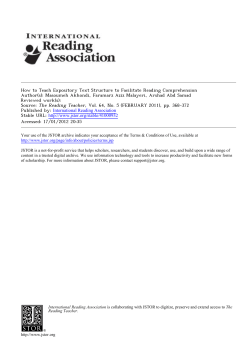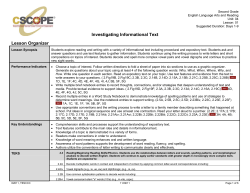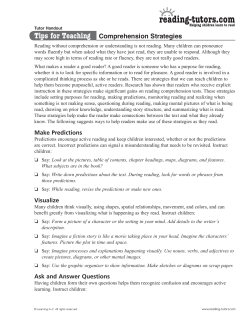
Document 99651
What is Exposition? Agroup of LAUSD high school teachers were asked to define exposition. The followinq are their definitions. Exposition is "explaininq a character, a process} a position} a problem ana solution, a cause ana effect, a comparison ana contrast. It is a snort story analysis, or sty[e analysis. JJ Exposition. explains, using compare/contrast) problem-solution, speculations about cause-effect) research. Exposition is writing that informs. It can include reports} research. papers) summaries} writing about a process} observational UJriting} 6usiness [etters. Exposition includes wor~pCace documents. 'Expository writing is a response to literature, using a variety of methods: compare/contrast) problem-soiution, evaluation of an argument) classification, cause-effect. rrfiepurpose of expository writing is to inform readers, Gut there is an emotional. appear to expository writing. Students must R.:,"10W the audience anapupese. fin expository essay seekJ to explain somethinq, to promote understandinq. Exposition: One of the four traditional forms of composition in speech and writing. Its purpose is to set forth or explain. - Reading/Language Expository text: Arts Frameowrk for California Public Schools, p. 276. A traditional fcrm of written composition that has as its primary purpose explanation of the communicaiton of details, facts, and discipline - or content-specific information. - Reading/Language ,I 3-208 Arts Frameowrk for California Public Schools, p. 276. r Expository Text Expository text is the vast majority of what is read in school, work, and.life. For this reason, it is critical that students understand how to read, analyze, distinguish, synthesize, create, and extend ideas presented in expository texts. Expository texts include essays, speeches, workplace and government documents, newspaper and magazine articles, instructions and directions, While expository text shares certain characteristics with the other types of text, exposition makes its own demands on the reader through the unique use of structure, devices, features, and conventions. We need to teach students how to read expository texts and how to read them successfully. "First, students need to understand the characteristics of an expository text. A narrative text includes such elements as a theme, plot, conflict(s), resolution, characters, and a setting. Expository texts, on the other hand, explain something by definition, sequence, categorization, comparison-contrast, enumeration, process, problem-solution, description, or cause-effect. Where the narrative text uses story to inform and persuade, the expository text uses facts and details, opinions and examples to do the same. John Steinbeck used narrative to describe what it was like for people during the Dust Bowl, but an economist would use exposition to explain the causes and consequences of the same event, drawing examples from various sources to illustrate his points, perhaps even including a graph or some photographs." (English Companion) ) Students Need to Know How to € 6 ., ., • ~ ., • € • • • • • J ./ read varied models of expository texts for a specific purpose. annotate the elements of expository texts . identify and use characteristics and features of expository text. recognize the transitional words that signal important information or a shift in focus in expository text to strengthen reading, writing, and comprehension skills. clearly understand the organization of exposition, (e.g., cause-effect, definition, persuasive). synthesize the content of primary and secondary sources . summarize paragraphs or sections of the text. pre-read and re-read expository texts for multiple purposes. understand and use strategies that orient and focus their reading. identify and discuss the main ideas throughout the expository text. develop their own questions and apply them to the text. develop visual tools that assist them in organizing their ideas. take effective notes for subsequent discussions or writing assignments. create their own text and extend ideas presented in other texts. Forms Common to Expository Text Expository text can be written in one of a number of forms. The term, "form," simply refers to the product being produced. If one were to write an explanation, (mode) for example, he might produce a brochure or an essay (form). Although both products have the same objective, to provide an explanation, the organizational and content expectations of each differ significantly. Forms that lend themselves to the construction of expository text include: Brochure How-to writing Newspaper article Catalog Letters Pamphlets Definitions Literary analysis Paraphrase Editorials Magazine Summaries Essays Memorandums Textbooks Guide books Newsletters Copied with permission from Bellingham Public Schools/ Bellingham Public Schools WWW. Author: Tara Felder ) 3-213 ,:". , .;c,',.- • _:-_', ~ • .: xposition: Content AcadernfC'ocatJularY Accuracy- agreement with facts; correctness. When using primary and secondary sources, information must be accurate and coherent (logical). Analysis (of text) - the separation of text into its components to determine the relationships between the parts and the whole in order to communicate or comprehend the structure of the underlying ideas. Analytical essay - (see analysis) uses cause/effect, problem/solution, or compare/contrast organizational patterns. Audience - group most likely to read or listen to the text the author creates. The intended audience will determine the way the information is presented. If the audience is mainly adults, the information will be more formal in presentation. If the audience is mainly young people, the information may be presented more informally. Bias - an inclination for or against that inhibits impartial judgment; one-sidedness, partiality, partisanship, prejudice. Cite - to quote as an example or authority. Claim - what the writer (or speaker) wants to prove; also called an assertion or position. Coherence - logical agreement among parts, consistency of ideas. When using primary and secondary sources, information must be accurate (correct) and coherent. , ) Content Literacy - being literate in a content area; being able to read, write, think, talk, solve problems, and learn as a mathematician, scientist, historian, poet, etc., about concepts and driving questions in each of these disciplines; being able to identify core ideas and concepts, questions to ask, problems to solve, and having habits of mind or content-specific strategies to examine those ideas, questions, or problems. Discourse - orderly thought or procedure; rational conversations. Discourse includes instructional conversations, collaboration, debate, expository oral presentations. Discourse can also include writing. Elaboration - adding information, usually in the form of details. This might include original ideas on a topic or researched information. Evaluation ) - examine to determine the significance or worth. Evidence - specific information or proof that supports the reasons/assertions in an argument. Evidence must be precise and relevant, clearly related to the argument. Types of evidence include: • Analogies: comparisons that show similarities between otherwise unrelated facts or ideas. Example: We should be as concerned about the garbage problem today as they once were about finding a vaccine for polio. • Anecdotes: personal examples or observations that illustrate a point. Example: My grandfather says theforests that once surrounded my hometown have nearly vanished. Case srudies: Examples from scientific research. Example: Government studies show that collecting and using recycled materials scves energy. ~ Com.nonly accepted beliefs: specific .nstances or illustrations ofa general idea. Example: Most people think that garbage is useless and has 710 value. Los Angeles Unified School District • Examples: Specific instances or illustrations of a general idea. Example: For example, recycling could help save some of the fifty thousand trees that are sacrificed evelY week to produce Sunday newspapers in the Us. Expert opinions: Statements made by a recognized authority on the subject. Example: Brenda Platt of the Institute for Local Self-Reliance says, "Studies have concluded that recycling costs less than traditional trash collection and disposal ... " Facts: Statements that can be proven true; some facts are in the form of statistics, or numerical information. Example: Garbage usually goes into landfills. Of the garbage produced each year in the Us., 42% is paper. a " Exposition - Exposition is a type of writing that explains, gives information, or clarifies an idea. This is the most common type of writing in school and in life. Expository Pattern * Expository Task Cue Words May Contain Reasons why; if ..then; as a result; therefore; because Cause/effect - The author lists one or more causes and the resulting effect or effects. « Classification - The author groups persons, places, things, or abstract ideas according to a common topic. fJ s Comparison - The author explains how t\1I'O or more things are alike and/or how they are different. ~ Alike; similar to; contrast; different • Definition - The author defines a topic or subject. '" " Description - The author describes a topic by listing characteristics, features, and examples. It Explain ... ; define ... ; write about ... Describe ... ; illustrate ... ; for example ... c: € ) Text Organizational W' • Persuasion - The author's intent is to convince the reader to view things from the author's point of VIew. Agree/disagree; support ... ; evidence that supports ... ; reaSO:1S Problem/solution - The author states a problem and lists one or more solutions for the problem. Problem is... ; solution(s) is/are ... Sequence- The author lists items or events in numerical or chronological order. Sequence also includes how to and process. * Most significant; least. .. ; greatest ... ; the characteristics are ... exposition may include combinations • First, second, third; next; then; finally of this organizational structures. Extend - extend ideas - broaden or to take further through analysis, evaluation, and elaboration. Features of expository text - Expository texts often contain visual clues to assist with comprehension: G Diagrams, charts, graphs, maps ~ Headings and subheadings e Typeface Main idea- the writer's most important point, opinion, or message. The main icea may be stated directly, or it may be suggested or implied. In persuasive texts, the main idea is called the claim. Los Angeles Unified School District 3-248 I Modern Language Association (MLA) - a format for student research papers concerning the ~ mechanics of writing, such as punctuation, quotation, and documentation of sources; MLA style has been widely adopted by schools, academic departments, and instructors for nearly half a century. Paraphrase - a restatement of text in other, especially simpler, words. A paraphrase follows the author's sequence of ideas without changing or omitting the author's ideas. A paraphrase is longer than a summary, which is a brief statement of the main ideas in a text. Perspective - point of view. 1'1. expository texts, relevant perspectives are those points of view directly related to a subject being investigated or explained. Point of view- vantage point from which a writer presents information, which may include the writer's biases and stereotypical beliefs. Primary source - a firsthand account. In primary sources, writers present their experiences, opinions, and ideas. Primary sources include autobiographies, letters, interviews, oral histories, eyewitness news reports, essays, editorials, and speeches. Purpose - goal, intention, aim. The purpose of expository text can be to inform, explain, present information, and persuade. Relevant - clearly related to an issue, argument, or main idea. ) Research report - a focused research essay, using primary and secondary sources. By focusing on a specific aspect of a topic, the research report can be 5-6 pages in length and contain all of the element of a much lengthier report. Secondary source - a secondhand account, often based on more than one viewpoint. 1'1. secondary sources, writers summarize, interpret, or analyze events in which they did not participate. Examples of secondary sources include encyclopedias and other reference works, textbooks, biographies, many magazine articles, and most newspaper articles. Significance - importance or value Support - supporting sentences that don't just provide evidence, but also elaborate on it. Every piece of support must clearly relate to the main idea. Synthesize - put different sources of information together to provide a more comprehensive understanding of the whole subject. Drawing conclusions about the information promotes synthesis. Text structure - any organizational patterns that writers use to make their meaning clear. The four basic ways to arrange texts include: chronological order, spatial order, order of importance, logical order. Other methods used to organize text are cause and effect, problem-solution, and question-answer. Thesis statement - a single sentence that represents the controlling idea or focus of an essay Tone - the writer's attitude toward his/her subject or audience. lf the writer's purpose is to inform.vne tone is usually serious, calm, and reasonable. . ) Los Angeles Unified School District 3-2MI
© Copyright 2025














